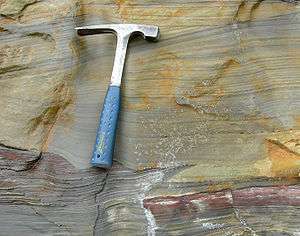Logan Formation
| Logan Formation Stratigraphic range: Lower Carboniferous (early Osagean) | |
|---|---|
|
Logan Formation exposed in Wooster, Ohio. | |
| Type | Sedimentary |
| Unit of | Waverly Group |
| Sub-units | Berne, Byer, Allenville, Vinton |
| Underlies | Maxville Limestone |
| Overlies | Cuyahoga Formation; Black Hand Sandstone |
| Thickness | 0 to 40 m |
| Lithology | |
| Primary | sandstone, siltstone, conglomerate |
| Other | shale |
| Location | |
| Region | Appalachian Basin |
| Country | United States |
| Extent | Ohio, West Virginia |
| Type section | |
| Named for | Logan, Ohio |
| Named by | Andrews, 1870 |
The Logan Formation is the name given to a Lower Carboniferous (early Osagean) siltstone, sandstone and conglomeratic unit exposed in east-central Ohio and parts of western West Virginia, USA.
Stratigraphy and paleoenvironment
The Logan Formation was named by Andrews (1870) and originally described as a "buff-colored, fine-grained sandstone" above the Waverly Formation and below the Maxville Limestone. Bork and Malcuit (1979) concluded that the Logan Formation was deposited on a shallow marine shelf in a generally transgressing sea. The age of the Logan Formation has been established as early Osagean (Tn3) by the occurrences of brachiopods, ammonoids, conodonts and miospores (Clayton et al., 1998; Matchen and Kammer, 2006).
References
- Andrews, E.B. (1870). "Report of progress in the second district, Part II, IN Report of progress in 1869". Ohio Division of Geological Survey Report of Progress, 2nd series: 1091–1094.
- Bork, K.B.; Malcuit, R.J. (1979). "Paleoenvironments of the Cuyahoga and Logan Formations (Mississippian) of central Ohio". Geological Society of America Bulletin. 90: 89–113. doi:10.1130/0016-7606(1979)90<1091:potcal>2.0.co;2.
- Clayton, G.; Manger, W.L.; Owens, B. (1998). "Mississippian (Lower Carboniferous) miospores from the Cuyahoga and Logan Formations of northeastern Ohio, USA". Journal of Micropalaeontology. 17: 183–191. doi:10.1144/jm.17.2.183.
- Matchen, D.L.; Kammer, T.W. (2006). "Incised valley fill interpretation for Mississippian Black Hand Sandstone, Appalachian Basin, USA: Implications for glacial eustacy at Kinderhookian-Osagean (Tn2-Tn3) boundary". Sedimentary Geology. 191: 89–113. Bibcode:2006SedG..191...89M. doi:10.1016/j.sedgeo.2006.02.002.
-

Conglomerate in the Logan Formation exposed in Wooster, Ohio, USA.
-

Brachiopod internal and external molds in the Logan Formation in Wooster, Ohio.
-
The bivalve Aviculopecten subcardiformis from the Logan Formation in Wooster, Ohio (external mold).
-

Bivalves (Aviculopecten) and brachiopods (Syringothyris) in the Logan Formation in Wooster, Ohio.
-

Cross-bedding and scour in the Logan Formation of Jackson County, Ohio.
-
Schizodus medinaensis; a bivalve from the Logan Formation in Wooster, Ohio (internal mold).
-
Syringothyris sp.; a spiriferinid brachiopod from the Logan Formation in Wooster, Ohio (internal mold).
-

Syringothyris external mold with borings; Logan Formation; Wooster, Ohio.
-

Syringothyris texta (Hall 1857), dorsal view, internal mold. Lower Carboniferous of Wooster, Ohio.
-
Helminthopsis ichnosp.; a trace fossil from the Logan Formation in Wooster, Ohio.
-
Crinoid calyx from the Logan Formation in Wooster, Ohio, with a conical platyceratid gastropod (Palaeocapulus acutirostre) attached.